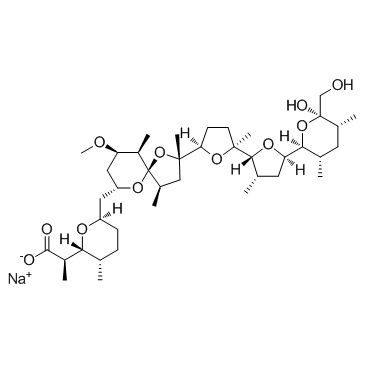28643-80-3
| Name | Nigericin sodium salt |
|---|---|
| Synonyms |
Nigericin,Natrium-Salz
2H-Pyran-2-acetic acid, tetrahydro-6-[[(2S,4R,5R,7R,9R,10R)-9-methoxy-2,4,10-trimethyl-2-[(2S,2'R,3'S,5R,5'R)-octahydro-2,3'-dimethyl-5'-[(2S,3S,5R,6R)-tetrahydro-6-hydroxy-6-(hydroxymethyl)-3,5-dimet ;hyl-2H-pyran-2-yl][2,2'-bifuran]-5-yl]-1,6-dioxaspiro[4.5]dec-7-yl]methyl]-α,3-dimethyl-, sodium salt, (αR,2R,3S,6R)- (1:1) nigericin.Na nigericin monosodium salt Leelamine hydrochloride Polyetherin A,Azalomycin M,Helixin C,Antibiotic K178,Antibiotic X-464 Sodium (2R)-2-[(2R,3S,6R)-6-{[(2S,4R,5R,7R,9R,10R)-2-{(2S,2'R,3'S,5R,5'R)-5'-[(2S,3S,5R,6R)-6-hydroxy-6-(hydroxymethyl)-3,5-dimethyltetrahydro-2H-pyran-2-yl]-2,3'-dimethyloctahydro-2,2'-bifuran-5-yl}-9-methoxy-2,4,10-trimethyl-1,6-dioxaspiro[4.5]dec-7-yl]methyl}-3-methyltetrahydro-2H-pyran-2-yl]propanoate nigericin sodium Nigericinsodiumsalt sodium nigericin Antibiotic K178,Antibiotic X464,Azalomycin M,Helexin C,Polyetherin A Sodium (2R)-2-[(3S,6R)-6-[[(2S,4R,5R,7R,9R,10R)-2-[(5S)-5-[(2R,3S,5R)-5-[(2S,3S,5R,6R)-6-hydroxy-6-(hydroxymethyl)-3,5-dimethyloxan-2-yl]-3-methyloxolan-2-yl]-5-methyloxolan-2-yl]-9-methoxy-2,4,10-trimethyl-1,6-dioxaspiro[4.5]decan-7-yl]methyl]-3-methyloxan-2-yl]propanoate Nigericin sodium salt Antibiotic K178 Antibiotic X464 Azalomycin M Helexin C Polyetherin A Nigericin (sodium salt) |
| Description | Nigericin sodium salt is an antibiotic from Streptomyces hygroscopicus that works by acting as an H+, K+, and Pb2+ ionophore. |
|---|---|
| Related Catalog | |
| In Vitro | Nigericin (0.1 µM) decreases inhibits proliferation and clonogenicity of H460 lung cancer cells in a dose dependent manner. Nigericin inhibits migration and invasion of H460 lung cancer cells[1]. Nigericin (0.1-10 nM) has apparently a dual effect on cell volume, that is a shrinking effect at lower Nigericin concentrations and a swelling effect at higher concentrations. Nigericin (0.1-1 nM) significantly decreases cytosolic pH (pHi), and slightly increases the pHi at 5 and 10 nM[2]. Nigericin exhibits higher toxicity on S18 cells than S26 cells, with IC50 of 2.03±0.55 μM and 4.77±2.35 μM, respectively. Nigericin can selectively kill cancer stem cells in NPC in vitro. Nigericin dramatically reduces the migration ability of S18 and HONE-1 cells[3]. Nigericin exhibits gteat toxicity for the HT29 and SW116 cell line with IC50 of 12.92±0.25 μmol and 15.86±0.18 μmol. Nigericin also shows a decreased ability to form colonies under anchorage-independent conditions in a standard soft agar assay[4]. |
| In Vivo | Ngericin (4 mg/kg, i.p.) significantly reduces tumor growth and acts synergistically with the chemotherapeutic agent DDP, as shown by the tumor volumes. Nigericin markedly decreases Bmi-1 in vivo. Overexpression of Bmi-1 partially restores CSC content and metastatic ability of NPC cells under Nigericin treatment. The downregulation of Bmi-1 may be involved in the inhibitory effect of Nigericin on CSCs in NPC[3]. |
| Cell Assay | For RCCs, cells (appr 2000 cells/well) are plated in 96-well cell-culture microplates and incubated over nigericinht in complete media (CM)-RPMI 1640 supplemented with 5% FBS, 2 mM l-glutamine, 100 U/mL penicillin, and 100 mg/mL streptomycin to allow them to adhere. Cells are then exposed to the appropriate concentration of drug or vehicle for 72 h. For PPSS, cells (appr 500 cells/well) are plated in 96-well cell-culture microplates incubated over Nigericinht in CM to allow them to adhere and then maintained in serum-free media for 7-8 days and then treated with the appropriate concentration of drug or vehicle for 72 h in SFM. Cell viability for cells growing under RCCs and PPSS are evaluated by the MTT assay. The absorbance of solubilized formazan is read at 570 nm using ELISA (enzyme-linked immunosorbent assay) reader. In all cases, the highest concentration of DMSO is used in the control and this concentration is maintained below 0.001% (v/v). This DMSO concentration does not show any significant antiproliferative effect on the cell line in a short-term assay. |
| Animal Admin | Mice[3] The S18 cells are injected near the scapula of the nude mice. Nine days after injection, the mice are randomly divided into four groups with six animals each (control, DDP, Nigericin and DDP combined with Nigericin). DDP (2.5 mg/kg) is injected intraperitoneally for five continuous days and nigericin (4 mg/kg) is administrated intraperitoneally every two days. Tumor length and width are measured with a vernier caliper every other day. Tumor volume is calculated using the formula V=0.5×(length×width2). The body weights of the mice are recorded every two days. Mice are humanely euthanized when the tumor volume reach 2000 mm3. |
| References |
| Density | 1.19g/cm3 |
|---|---|
| Boiling Point | 779.9ºC at 760mmHg |
| Molecular Formula | C40H67NaO11 |
| Molecular Weight | 746.943 |
| Flash Point | 226.9ºC |
| Exact Mass | 746.458130 |
| PSA | 145.20000 |
| LogP | 4.37090 |
| Vapour Pressure | 4.26E-28mmHg at 25°C |
| Storage condition | 2-8°C |
| Water Solubility | Soluble in chloroform, methanol or ethanol |
CHEMICAL IDENTIFICATION
HEALTH HAZARD DATAACUTE TOXICITY DATA
|
| Symbol |

GHS06 |
|---|---|
| Signal Word | Danger |
| Hazard Statements | H301-H315-H319-H335 |
| Precautionary Statements | P261-P301 + P310-P305 + P351 + P338 |
| Personal Protective Equipment | Eyeshields;Faceshields;Gloves;type P2 (EN 143) respirator cartridges |
| Hazard Codes | T: Toxic; |
| Risk Phrases | R25;R36/37/38 |
| Safety Phrases | S26-S36/37/39-S45 |
| RIDADR | UN 3462 |
| WGK Germany | 3 |
| RTECS | QT6840000 |
| Packaging Group | III |
| Hazard Class | 6.1(b) |
| HS Code | 29419090 |
